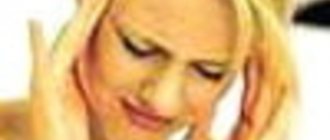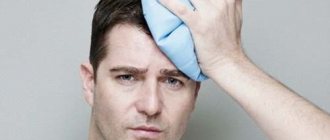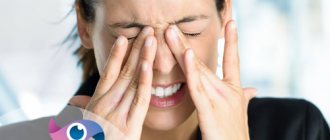A headache in the back of the head is not always harmless; it is often a symptom of a serious illness. If it occurs suddenly or, in medical terms, acutely, then the reasons for its appearance may be not only neurological, but also vascular or even infectious. In such cases, you should seek medical help immediately.
Chronic pain in the occipital region deserves deeper consideration, since many often do not take it seriously and try to eliminate it with the help of conventional painkillers. Such pain periodically makes itself felt and reduces the quality of life at the time of its occurrence. Most often, patients can trace a clear connection between its occurrence and the action of a specific factor. For some, it may occur after a long stay in an uncomfortable position, a sharp turn of the head, or microtrauma. This indicates the need to look for the cause of the disorder in pathological changes in the musculoskeletal system, in particular the cervical spine.
Causes of pain in the back of the head on the right side of the head
If you have a headache in the back of your head on the right, it is important to find out the exact cause of this symptom. It is worth understanding that it can also manifest itself in a healthy person. Stress, physical and mental fatigue, high air pollution and other factors can provoke ischemia of certain areas of the brain and pain in the occipital part of the head on the right. However, examination may reveal acute and chronic diseases that cause headaches in the back of the head on the right.
Inflammation of the occipital nerve
The greater occipital nerve originates from the second cervical nerve and passes under the base of the skull. It follows to the scalp through the muscles of the neck and back of the head. Neuralgia can be a consequence of inflammation or mechanical damage to nerve fibers. Its causes are injuries and chronic diseases of the cervical spine, constant muscle spasms. The following factors can also trigger the disease:
- incorrect posture;
- uneven neck position when sitting for a long time;
- intense physical activity.
With occipital neuralgia, pain can be constant or paroxysmal. The patient has pain on the right side of the back of the head, discomfort spreads to the front, temple and eyeball. Most often, painful sensations are concentrated only on the left or right side, but they can be symmetrical. Treatment is with anti-inflammatory drugs, antibiotics and muscle relaxants.
High blood pressure
If the occipital part of the head on the right hurts, you should immediately measure your blood pressure. Many patients have hypertension - an increase in pressure more than 120/80 mm. rt. Art. This is an acute or chronic condition that is dangerous due to the high load on the heart muscle and the gradual weakening of blood vessels. The disease can be caused by chronic arterial diseases, atherosclerosis, and dysregulation of vascular tone. It manifests itself with characteristic symptoms:
- pain on the right or left side of the back of the head;
- redness of the skin and mucous membranes;
- the appearance of small pinpoint hemorrhages under the skin;
- dizziness, fainting is possible during an acute attack.
Headaches in the right back of the head can be caused by increased intracranial pressure. This value cannot be measured independently, so the diagnosis is made based on indirect symptoms. It represents the total pressure of blood, cerebrospinal fluid and brain tissue. Its increase causes chronic headaches, dizziness, fainting, and also dangerous ischemia of certain parts of the brain. Treatment is symptomatic and includes medications to reduce blood pressure and remove excess fluid from the body.
Cervical migraine
Pain in the back of the head on the right or left is a characteristic symptom of cervical migraine. The disease is caused by impaired blood flow through the vertebral artery, which may be due to abnormalities in its structure, mechanical compression, or other factors. Its main cause is damage to the roots of the 1st, 2nd and 3rd spinal nerves, which are normally located around the vertebral artery. Cervical migraine can accompany the following diseases:
- osteochondrosis is a chronic degenerative disease in which thinning and destruction of intervertebral cartilage and deformation of bone segments occur;
- spondylosis – fusion of two adjacent vertebrae, as a result of which the damaged area loses mobility;
- injuries of the cervical spine, as well as their consequences (improper fusion of bones, formation of calluses);
- lymphadenitis - inflammation of the lymph nodes in the neck;
- stenosis (narrowing) of the vertebral artery.
With cervical migraine, the patient has a headache in the back of the head on the right or left. The pain is acute, accompanied by blurred vision, increased heart rate, weakness, and dizziness. They go away if the main cause of the disturbance in blood flow in the vertebral artery is eliminated. Physiotherapy sessions, medications to improve blood supply to the brain, and painkillers are also prescribed.
Myogelosis of the trapezius muscle
Myogelosis is a thickening of muscle tissue. It can occur not only in the trapezius, but also in any other skeletal muscle, often diagnosed in the cervical spine. Its causes are injuries, prolonged exposure to a forced unnatural position, and intense physical activity. It can also occur as a result of osteochondrosis, protrusions and intervertebral hernias.
Pain in the occipital region on the right is a characteristic sign of myogelosis of the trapezius muscle. They are also localized directly at the site of compaction, and the skin over this area may become inflamed and acquire a red tint. The patient is concerned about painful sensations, as well as nausea, dizziness, limited mobility of the neck and shoulder girdle. Treatment is prescribed individually. The regimen may include massage, physiotherapy, muscle relaxants, as well as local medications (ointments, gels) with analgesic and anti-inflammatory effects.
Vascular disorders
Spasm of the arteries carrying blood to the brain is one of the common reasons why the right side of the back of the head hurts. The condition is a narrowing of the lumen of the vessel, as a result of which blood does not flow to the tissues in sufficient quantities. Spasm can have two main causes:
- neurogenic - a violation of the central regulation of vascular tone caused by pathologies of the nervous system;
- mechanical - compression of the vessel or the appearance of obstacles on their inner wall.
Vascular spasm caused by neurogenic causes occurs abruptly. Tension of the artery wall causes a narrowing of its lumen, and blood pressure rises. The condition leads to acute headache and dizziness, and is also dangerous for the rupture of an important vessel. During an attack, bed rest and limited physical activity are recommended.
If the patient often has pain in the right occipital part of the head, this may indicate chronic mechanical compression of the vessel. The condition is caused by diseases of the cervical spine, osteochondrosis, spondylosis and other pathologies. If the pressure comes from outside, it is important to eliminate the cause and restore normal blood flow. However, narrowing of the artery lumen can be caused by atherosclerosis, in which deposits and plaques form on the inner wall. In this case, it is necessary to limit exercise, monitor blood pressure, follow a diet and take medications to correct lipid metabolism.
Injuries
Often the causes of pain are head or neck injuries. In particular, this leads to a significant increase in blood pressure, disruption of the integrity of the skin, as well as intracranial hemorrhage. In such a situation, the symptom appears either immediately after a blow or other mechanical impact, or after a certain time. It is worth noting that cephalgia is characterized by a regular nature.
In most cases, the localization of sensations corresponds to the site of injury. Associated symptoms may include nausea, dizziness, poor coordination, confusion, short-term memory loss, even fainting.
Delayed pain on the left side of the head may appear after a temporary improvement in the patient’s general condition. If necessary, he should undergo diagnostics to ensure that there are no extensive hematomas or bleeding.
The method of treatment for such conditions directly depends on the type of injury and the condition of the patient. If the damage is not severe, then you can limit yourself to bed rest, a compress applied to the problem area, and also taking painkillers. In other situations, only a qualified physician can advise you on how to proceed based on your specific injury.
Diagnostic methods
Timely diagnosis will allow you to determine the exact cause of pain in the right side of the back of the head and begin treatment. This will require an examination by a therapist, neurologist, traumatologist or other specialists as indicated. Additional examinations are also prescribed that are aimed at detecting or excluding specific diseases:
- X-ray of the cervical spine is the main method for diagnosing injuries, fusion of the vertebrae, and their deformation;
- MRI, CT of the neck and head are the most accurate, informative methods, thanks to which you can detect diseases of blood vessels and soft tissues, as well as neoplasms, cysts, aneurysms;
- blood tests will show the presence of an inflammatory process, and will also indicate diseases of the internal organs;
- Dopplerography - examination of blood vessels using ultrasound after adding a contrast agent.
A simple examination will not help determine the reasons why the right back of the head hurts. This will require various instrumental examinations and analyses, the accuracy of which depends on the quality of the equipment and the qualifications of specialists. The Clinical Brain Institute has modern equipment for diagnosing diseases of the neck and head, and also employs doctors with many years of experience. This makes it possible to identify complex diseases in the early stages and successfully treat them without complications.
Vascular diseases
Pathological processes that develop in the vessels of the back of the head and neck provoke circulatory disorders. They are accompanied by headaches. Alarming signs appear already in the initial stages of vascular diseases, intensifying under the influence of external factors. Including excessive exercise, lack of sleep, weather changes, alcohol abuse and smoking.
When the left side of the back of the head hurts severely, it is often associated with vascular problems. It is not recommended to start taking antibiotics uncontrollably. To alleviate symptoms, in some cases it is sufficient to normalize the emotional background, and if hypertension is diagnosed, lower blood pressure. In this case, ventilation of the room, foot baths, and taking medications as prescribed by the doctor help.
In reviews of pain in the left side of the head, patients who have repeatedly encountered this illness note that the fight should begin with identifying the causes of the disease. There are quite a lot of diagnostic methods today - this includes interviewing the patient and examining him, urine and blood tests, CT, MRI, ultrasound of the vessels of the neck and brain, as well as X-ray EEG.
Only after making an accurate diagnosis can the doctor develop a detailed treatment regimen that will be aimed at eliminating the main provoking factor and accompanying symptoms. The patient must understand that migraine medications will not help with hypertension, so you should not self-medicate, since you will still not be able to make a diagnosis.
If pain occurs one-time, it is recommended to go for a walk or ventilate the room, sleep or rest if possible, do light exercises for the neck or massage the collar area. It is also recommended to drink mint-based tea, which effectively soothes; you can add lemon balm, motherwort, and valerian to it. Healers advise placing a cloth soaked in cabbage juice on the affected area, and also massaging the temples with essential oils of mint, lemon, and orange.
Treatment of pain in the back of the head
Pain in the right occipital part of the head is not a separate disease, but one of the symptoms of a number of pathologies. The set of techniques will include techniques to relieve symptoms and to eliminate the main cause of pain in the back of the head on the right. Most of them are available at home, but are carried out only with a doctor's prescription.
- Drug treatment is the main stage. The patient is prescribed muscle relaxants, drugs to correct blood pressure, substances to improve blood supply and nutrition to the brain. Additionally, medications may be prescribed to improve lipid metabolism and remove bad cholesterol, and medications to nourish intervertebral cartilage.
- Massage and physical therapy are an important step for neck diseases, spinal curvatures, and osteochondrosis. You can do it yourself, at home, but massage is only effective if performed by a specialist.
- Diet is necessary for atherosclerosis, osteochondrosis and other diseases. The patient's diet should contain a large amount of fiber and vitamins. You should avoid spicy, fatty foods, and excess animal products.
- Physiotherapy is effective for muscle and vascular spasms, chronic diseases of the cervical spine. The procedures are carried out in a course, with an interval of several days. Exposure to heat, laser, ultrasound, electric current or magnetic radiation stimulates blood circulation and regeneration processes.
In most cases, treatment is carried out with medications that the patient must take at home. However, in case of exacerbation of diseases, suspicion of the development of complications, as well as for additional diagnostics, the Clinical Institute of the Brain has the possibility of inpatient treatment and examination. This allows you to be under the supervision of qualified doctors and staff around the clock and accurately track the dynamics of disease development.
Ways to prevent headaches
Pain in the right occipital part of the head can be prevented at home. To do this, you should follow several rules recommended by doctors:
- monitor your posture while walking and working in a sitting position;
- devote time to physical activity every day, carry out moderate loads;
- get rid of excess weight - it becomes a source of problems with joints, blood vessels, and metabolic disorders;
- Maintain a healthy diet with sufficient vitamins and minerals.
Pain in the back of the head on the right is a symptom that is important to pay attention to in time. Doctors at the Clinical Institute of the Brain recommend contacting for diagnosis at the initial stages. Most diseases that cause headaches can progress and lead to dangerous consequences. However, this can be prevented if the cause is addressed in the early stages.
Clinical Brain Institute Rating: 5/5 — 17 votes
Share article on social networks







